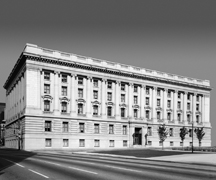U.S. Custom House (Baltimore, Maryland)
|
U.S. Custom House
|
|

Baltimore Custom House
|
|
| Location | 40 S. Gay St., Baltimore, Maryland |
|---|---|
| Coordinates | 39°17′18″N 76°36′34″W / 39.28833°N 76.60944°WCoordinates: 39°17′18″N 76°36′34″W / 39.28833°N 76.60944°W |
| Area | 1 acre (0.40 ha) |
| Built | 1903 |
| Architect | Hornblower & Marshall; Millet, Francis Davis |
| Architectural style | Beaux-arts |
| NRHP Reference # | 74002217 |
| Added to NRHP | February 15, 1974 |
U.S. Custom House is a historic custom house building located at Baltimore, Maryland, United States. It is a granite, steel frame structure measuring 252 feet, 8 inches by 139 feet 6 inches. It is an exceptionally distinguished example of Beaux Arts architecture and was built from 1903 through late 1907 from plans by Hornblower and Marshall, a Washington, D.C. firm. The ceiling of the Call Room, located in the pavilion, was painted by Francis Davis Millet (1846–1912). It served as Baltimore’s Custom House until 1953. Since that time various Federal agencies have occupied the building.
U.S. Custom House was listed on the National Register of Historic Places in 1974.
In the 18th and 19th centuries, Baltimore flourished as one of the nation's major commercial ports, its economy growing as foreign trade increased. In 1789, the First U.S. Congress established the United States Customs Service and named Baltimore as one of 59 collection districts. The first Baltimore custom house was at the intersection of South Gay between East Lombard and Water Streets, across from the present location. Around 1820 the government began to rent a wing of the Merchants' Exchange Building to house the Customs Service. Designed by J. Maximilian Godefroy, (1765-1838), and famous British-American architect Benjamin Henry Latrobe, (1764-1820), in an 'H' shaped structure and constructed in 1816-1820, the Merchant's Exchange Building was the largest domed building of its kind in America and a landmark of the city symbolizing its commercial importance. It continued to house the U.S. Customs Service, along with the U.S. Courthouse for District and Circuit Court of Appeals, Post Office and a branch of the Bank of the United States and separate wings for the first City Hall and another for offices of shipping companies, brokers, attorneys and related maritime businesses through the end of the 19th Century. In April 1865, the rotunda was the site of a viewing ceremony during the long procession winding through the downtown city streets for assassinated 16th President Abraham Lincoln as later his decorated train traveled through the Northern States back to his home in Springfield, Illinois for burial.
...
Wikipedia



